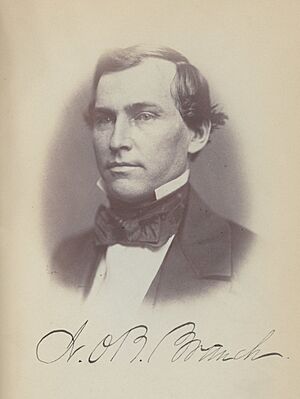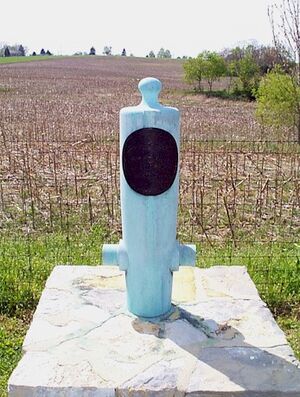Lawrence O'Bryan Branch facts for kids
Quick facts for kids
Lawrence O'Bryan Branch
|
|
|---|---|
 |
|
| Member of the U.S. House of Representatives from North Carolina's 4th district |
|
| In office March 4, 1855 – March 3, 1861 |
|
| Preceded by | Sion Hart Rogers |
| Succeeded by | John T. Deweese (1868) |
| Personal details | |
| Born | November 28, 1820 Enfield, North Carolina |
| Died | September 17, 1862 (age 41) Sharpsburg, Maryland |
| Political party | Democratic |
| Spouse | Nancy Haywood Blount |
| Alma mater | University of North Carolina at Chapel Hill Princeton University |
| Military service | |
| Allegiance | Confederate States of America |
| Branch/service | Confederate States Army |
| Years of service | 1861–62 |
| Rank | Brigadier General (CSA) |
| Battles/wars | Seminole Wars American Civil War |
Lawrence O'Bryan Branch (born November 28, 1820 – died September 17, 1862) was an important figure in North Carolina history. He served as a representative in the U.S. Congress. Later, he became a Confederate brigadier general during the American Civil War. He was killed in battle at Antietam. Like many wealthy people in the South at that time, his family's wealth was connected to the labor of enslaved people.
Contents
Early Life and Education
Lawrence O'Bryan Branch was born in Enfield, North Carolina. His parents were Major Joseph Branch and Susan Simpson O'Bryan Branch. When he was young, his family moved to Williamson County, Tennessee. Sadly, both his parents passed away when he was a child.
His uncle, John Branch, became his guardian. John Branch was then the Governor of North Carolina and later served as the United States Secretary of the Navy. Lawrence moved back to North Carolina with his uncle. He also lived in Washington, D.C. when his uncle worked there.
Branch received a good education. He studied with a private teacher in Washington, D.C. He also attended Bingham Military Academy in North Carolina. He spent a short time at the University of North Carolina at Chapel Hill. In 1838, he graduated first in his class from Princeton University. After college, he studied law in Nashville, Tennessee. He also owned and edited a newspaper there.
Law and Politics Before the War
In 1840, Lawrence Branch moved to Tallahassee, Florida. He became a lawyer there. Just one year later, he joined the fighting in the Seminole Wars. In 1844, he married Nancy Haywood Blount. They had four children together.
In 1852, Branch moved to Raleigh, North Carolina. He continued to work as a lawyer. He also became the president of the Raleigh & Gaston Railroad Co. He was chosen as an elector for Franklin Pierce in the 1852 presidential election.
Branch was elected to the U.S. Congress as a Democrat. He served three terms, from March 4, 1855, to March 3, 1861. He decided not to run for re-election in 1860. In 1859, he had a disagreement with another congressman, Galusha A. Grow. They were arrested before they could have a duel. In 1860, President James Buchanan offered him the job of Secretary of the Treasury, but Branch turned it down.
Service in the Civil War
When the American Civil War began, Branch joined the Confederate Army in May 1861. He started as a private soldier. Later that month, he became the state's quartermaster general, which meant he was in charge of supplies. However, he soon left that job to serve in the field.
In September 1861, he was chosen as a colonel for the 33rd North Carolina regiment. In January 1862, he was promoted to brigadier general. After the Battle of New Bern, his group of soldiers (called a brigade) joined A.P. Hill's Division. This division was part of Stonewall Jackson's Corps. Branch was the highest-ranking brigadier general in Hill's division.
Branch's brigade fought in many important battles. These included the Battle of Hanover Courthouse, the Seven Days Battles, Cedar Mountain, Second Manassas, Chantilly, and Harper's Ferry.
Death at Antietam
On September 17, 1862, General Branch led his troops on a fast march. They went from Harpers Ferry to Sharpsburg, Maryland. A huge battle, the Battle of Antietam, was happening there. Branch and his men arrived around 2:30 PM. They helped stop the Union army's advance. This action helped save General Robert E. Lee's army from a major defeat.
Soon after this success, Branch was talking with other generals. These included Maxcy Gregg, Dorsey Pender, and James J. Archer, along with Generals Hill and Lee. A Union sharpshooter saw the group and fired a shot. The bullet hit Branch, and he died instantly. Another general, Maxcy Gregg, was also wounded in the leg by the same shot. Branch fell into the arms of a staff officer.
Military Ranks Held
- Private: May 1, 1861
- Colonel: September 1, 1861
- Brigadier General: January 16, 1862
Legacy and Burial
Today, a special memorial cannon stands where Lawrence Branch was killed. Five other memorial cannons are also placed around the Antietam Battlefield. They mark the spots where other commanders lost their lives.
Lawrence O'Bryan Branch is buried at the Old City Cemetery in Raleigh, North Carolina.
The famous author Armistead Maupin is Lawrence Branch's great-great-grandson.
See also


